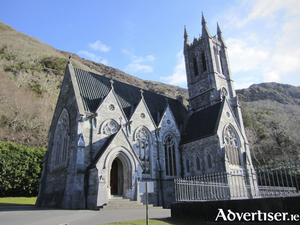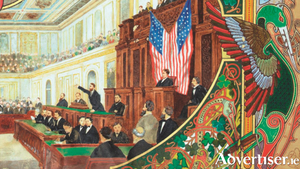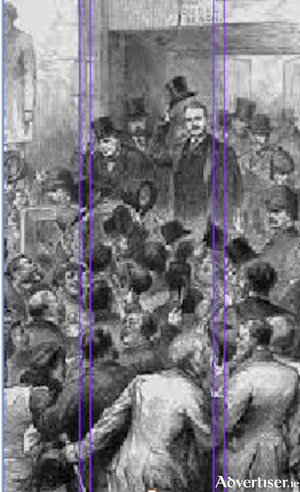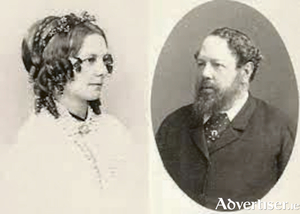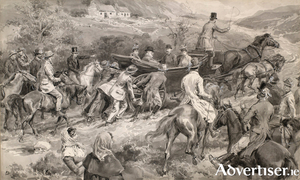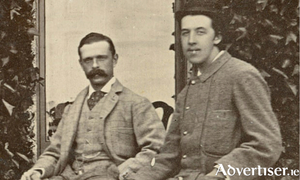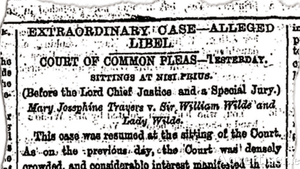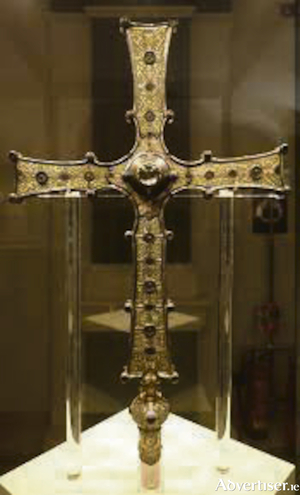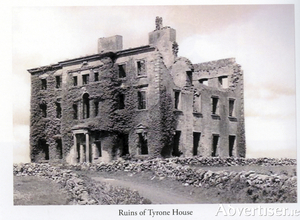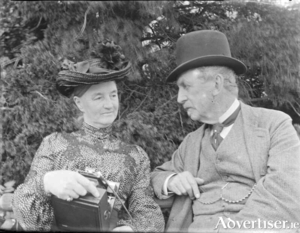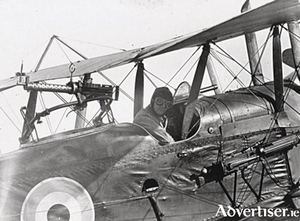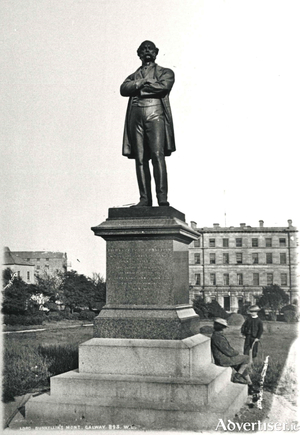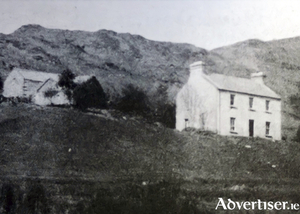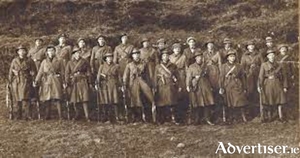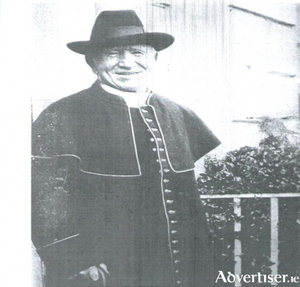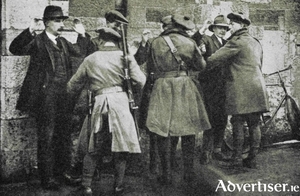‘A pale granite dream, afloat on its own reflection’
Thu, Sep 29, 2022
Mitchell Henry’s final days in Kylemore were sad ones. His adored wife Margaret had died at 45 years-of-age, and rested in a simple brick mausoleum in the grounds of his palatial Kylemore Castle. His political life, into which he put a great deal of personal effort, advocating on behalf of all Irish tenants the rights for them to own their own land, was out manoeuvred by Charles Stewart Parnell and the Land League. Henry described the Land League methods as ‘dishonest, demoralising and unchristian’. He probably was not surprised to lose his Galway seat in the general election of 1885. He blamed ‘Parnalite intimidation’.
Read more ...The only show in town was Charles Stewart Parnell
Thu, Sep 22, 2022
Week IV
On Friday September 17 1880 seventy-eight RIC officers arrived in Clifden from Galway. The following morning they walked out to the Bunowen estate of Charles J Blake to serve notices of eviction on 16 tenants, most of whom derived their livelihood from collecting kelp and subsistence fishing. As a result of the collapse of the kelp industry, rent arrears were between a year and a half, and two years. Other tenants were widows, where the only place left for them was the workhouse.
A different type of politics was needed
Thu, Sep 15, 2022
When Mitchell Henry entered Westminster parliament in 1871 he went with hope in his heart and a mission to tell the British people the precarious circumstances of the Irish tenant farmer. In many ways he resembled Jefferson Smith in the Frank Cappa film ‘Mr Smith Goes to Washington’ where a naive, idealistic young man has plans to change America.* Mitchell Henry, a liberal, kindly man, had plans to be a voice for the Irish tenant farmer within, what he believed, was a paternalistic landlord system, but he walked into a political cauldron, waiting to explode.
Read more ...Fantasy castles in 19th century Connemara
Thu, Sep 08, 2022
It must have been an extraordinary sight in the 1860s to see Kylemore castle rise from a bog in the heart of Connemara’s Twelve Pins, barely a decade following the devastation of the Great Famine. More than 100 men were employed, some coming from as far away as Renvyle and further, at a handsome wage of seven to 10 shillings a week, turning rough, soggy land, only good for shooting wild fowl and for fishing in its nearby lakes, into a magnificent building. Today it stands more like a palace than a castle, and is still a show-stopper on the Letterfrack road.
Read more ...O’Loughlin’s cavalry protected the king
Thu, Sep 01, 2022
The arrival of British royalty on Irish shores in recent times, is usually greeted with genuine interest and curiosity, and a sense of welcome and respect, while extreme nationalists have to grin and bear it.
Read more ...Bankruptcy and scandal plagued the brilliant Wilde family
Thu, Aug 25, 2022
‘Westward Ho! Let us rise with the sun, and be off to the land of the west - to the lakes and streams - the grassy glens and fern-clad gorges - the bluff hills and rugged mountains - now cloud-capped, then revealed in azure, or bronzed by evening’s tints, as the light of day sinks into the bold swell of the Atlantic….’
Read more ...How Sir William’s ‘moral chloroform’ seduced a young woman
Thu, Aug 18, 2022
‘ The case is exciting intense interest, and already the sheriff is over-powered with applications for admission to the court, but the police have taken precautions to prevent any undue overcrowding’.
Read more ...The family secret that Sir William and Lady Wilde hid from society
Wed, Aug 10, 2022
The appointment of William Wilde as assistant commissioner for the 1851 Census, which covered the time of the Great Famine, and would challenge the various guesstimates of the number of its victims, was initially seen as foolhardy.
Read more ...The priest who stole Cong’s famous cross
Thu, Aug 04, 2022
The Cross of Cong, one of Ireland’s great ecclesiastical treasures, was reputedly made at Cloncraff monastary, Co Roscommon. Its unsurpassed craftsmanship was inspired by its relic, a splinter of the wood of the cross on which Christ was crucified.
Read more ...“They had their great days and peace and plenty...”
Thu, Jul 28, 2022
Week IV
For a time Tyrone House must have accurately resembled the scene described by Violet Martin in a letter to her friend Edith Somerville where ‘half-peasant families roosted together in that lovely house and fought, and barricaded, and drank, till the police had to intervene’.
The woman at the door of Tyrone House
Thu, Jul 21, 2022
On the afternoon of March 18 1912, Violet Martin and her friend Tilly Redington, arrived at the door of Tyrone House, the home of the less than ordinary St George family. The three storey house, in the luxurious Palladian style, and said to be sumptuously decorated inside, is dramatically located by the estuary of the Kilcolgan river, about 2 miles distant from Kilcolgan village.
Violet was related to the Martins of Ballynahinch. Her father boasted that like his cousin Humanity Dick he had not lost one of his tenants during the Great Famine. The cost of such generosity was bankruptcy which both families bore as bravely as they could. On this March afternoon Violet was an established author. She and her cousin Edith Somerville of Castletownshend, West Cork, had effectively cooperated in a series of books on the landlord class. They had just published what would be their most successful novel: ‘Some Reminiscences of an Irish RM’.*
Read more ...Britain washed its hands of the Irish landlord class
Thu, Jul 14, 2022
After World War I the remnants of the Anglo Irish landlord class, found themselves marooned in a new, more democratic social world which some of them resented as plutocratic and vulgar.
Read more ...‘The peasantry are the foundation of the world - the upper classes get worn out’
Thu, Jul 07, 2022
In the decades preceding the 1916 Rising, an extraordinary revolution had already taken place in rural Ireland. The British government had lost its patience with Irish landlords who owned 95 per cent of the land of Ireland (100 percent of county Galway was landlord owned), and had largely squandered their wealth leaving themselves vulnerable to poor harvests, successive seasons of bad weather, and an increasingly impoverished tenantry.
Read more ...‘The two luckiest Girls in Galway’
Thu, Jun 02, 2022
Knowledge of how to read the sea is a rare gift. Patrick Oliver, one the last of the Claddagh fishermen, who once had a fleet of 200 boats in the bay, carries on the family tradition successfully catching lobster and crab. Patrick knows the local coastal waters like few others. When on Thursday morning August 13 2020, he heard that the two young women, Sara Feeney (23) and Ellen Glynn (17), who had set out from Furbo beach on their inflatable paddle boards the evening before, were still missing, he phoned his brother Dave who had been out all night on the Galway lifeboat searching.
Read more ...All for the tip of a finger….
Thu, May 26, 2022
On a wet and windy night off the coast of Mayo, the big Search and Rescue 116, Sikorsky S92 helicopter, was preparing to land at Blacksod lighthouse to refuel. It was Monday evening March 13 2017.
Read more ...One hundred years ago this week…
Thu, May 19, 2022
John Henry Foley was one of the greatest artists this country produced in the 19th century. He was a world famous sculptor who was commissioned to produce many public works in different parts of the world including Galway. The statue he produced here was of Lord Dunkellin, a 2.5 metre high bronze on a polished Peterhead red granite base which stood on two steps of Aberdeen granite about 20 yards inside the main gate into the Square. ‘In none of the great works which have given him world-wide celebrity has he shown more genius and skill than in the present instance where, with only the slender assistance of a photograph, has he been able to produce the faithful likeness.’
Read more ...The legend of the last battle in Connemara
Wed, May 18, 2022
During the war of Independence the West Connemara IRA brigade, under the command of Petie McDonnell, was an effective and disciplined force. It had moved its headquarters to the Muintir Eoin residence of Pádraic Mór Ó Máille, a two-storey farmhouse, backed by rock and heather covered hills, which stood on a small rise, along the Maam to Leenane road. It offered commanding views of the Maam Valley.
Read more ...Wild nights of burning and murder
Wed, May 11, 2022
Clifden was not the only town to experience the terror of British forces running wild, shooting, and setting fire to buildings. The previous year, July 19 1920, Tuam suffered a similar experience as Clifden, only mercifully no resident was killed on that occasion.
Read more ...The attack on Clifden, ‘something of this sort…’
Thu, May 05, 2022
Under the heading ‘Panic in the town last night’ The Connacht Tribune told the story of the attack on Clifden on March 19 1921: ‘Following the shooting of RIC Constable Reynolds, and the wounding of Constable Sweeney (who was to die from his wounds some hours later), at Clifden last night, panic reigned in the town and nine of the principal houses were burned.
Read more ...Murder and mayhem in Clifden
Thu, Apr 28, 2022
Just before 6am on St Patrick's Day 1921, Monsignor McAlpine, the Catholic parish priest of Clifden, Co Galway, was woken by loud banging on his door. “For God's sake, Canon, come down - the town is ablaze.”
Read more ...